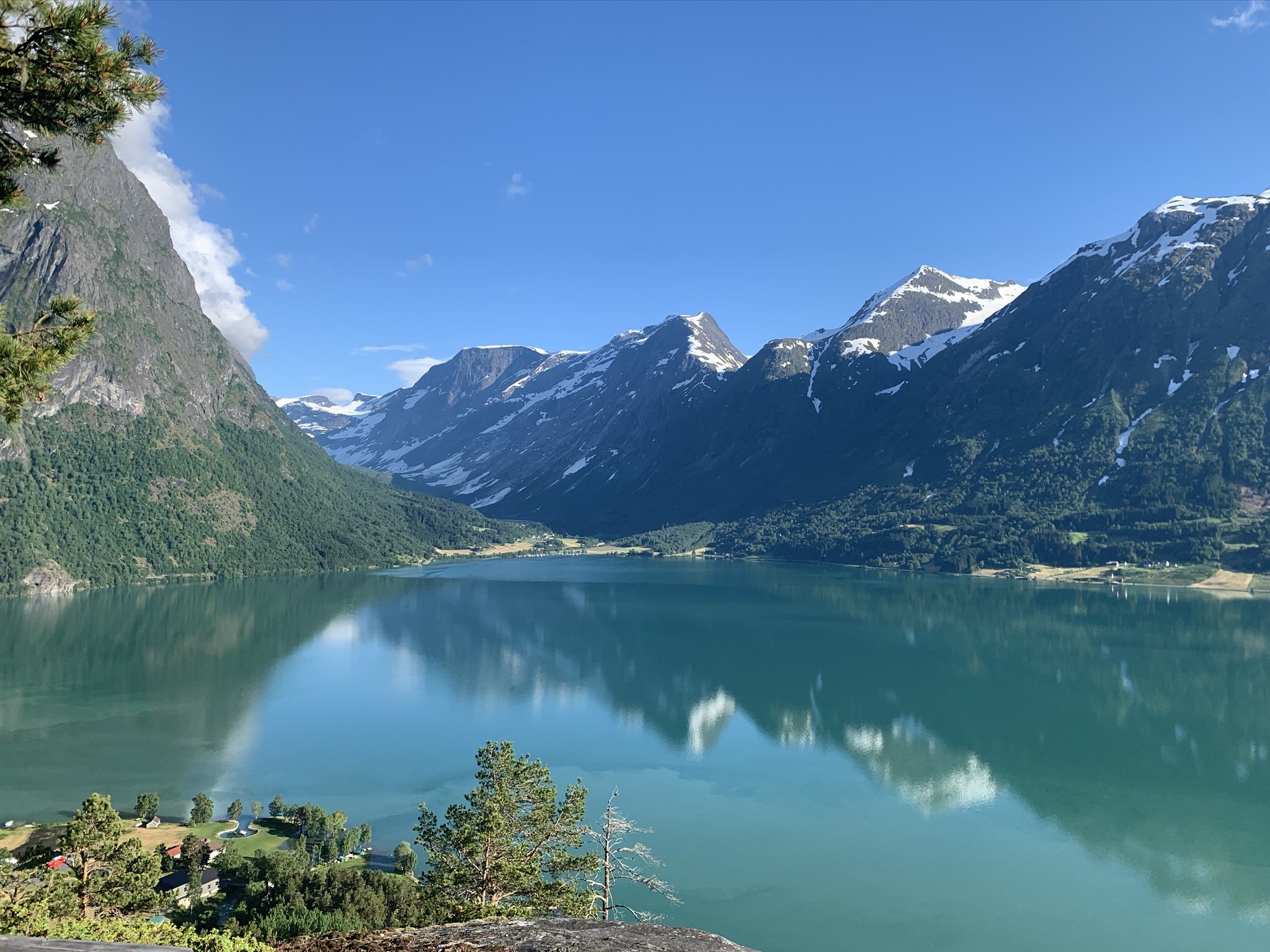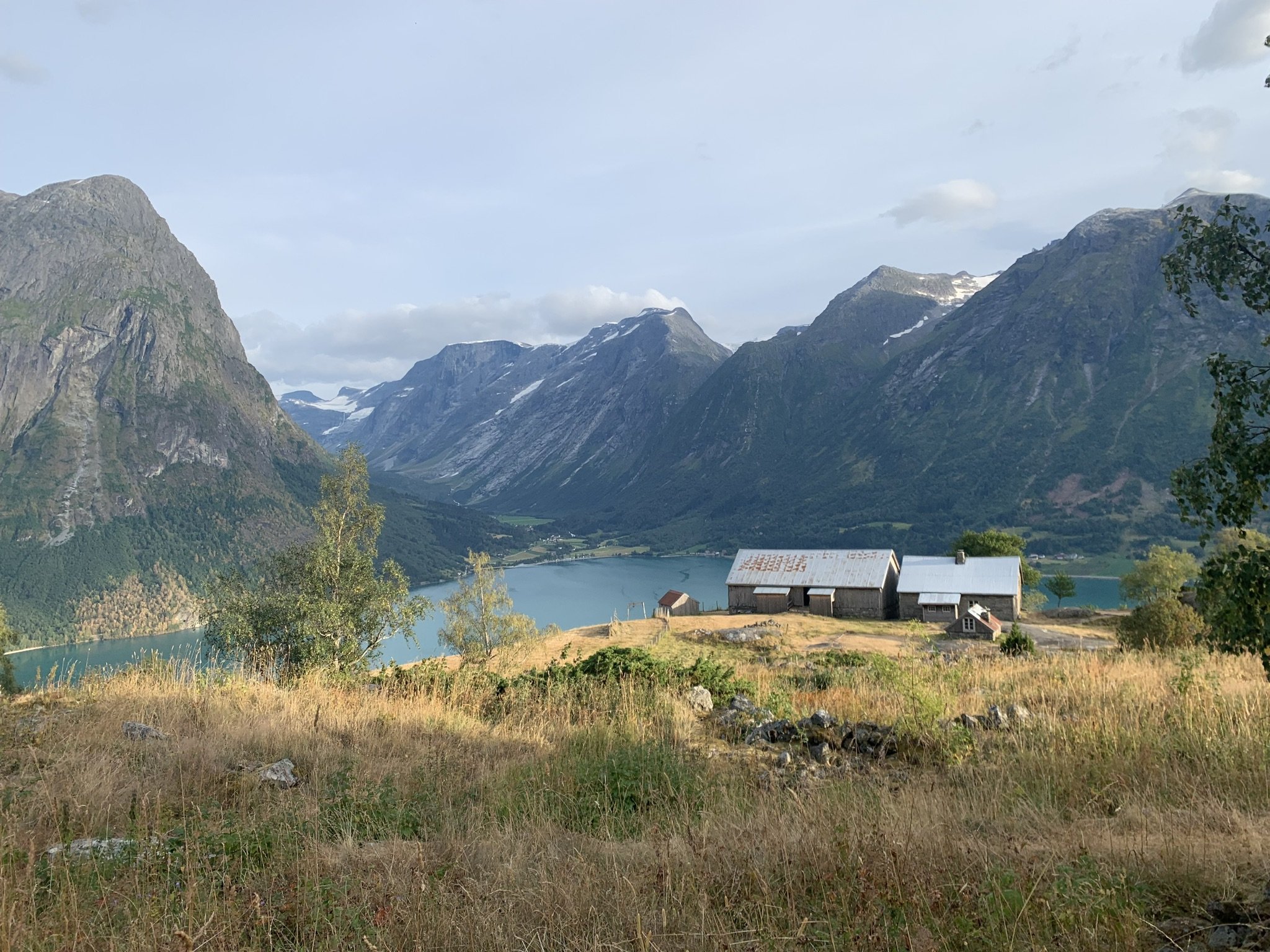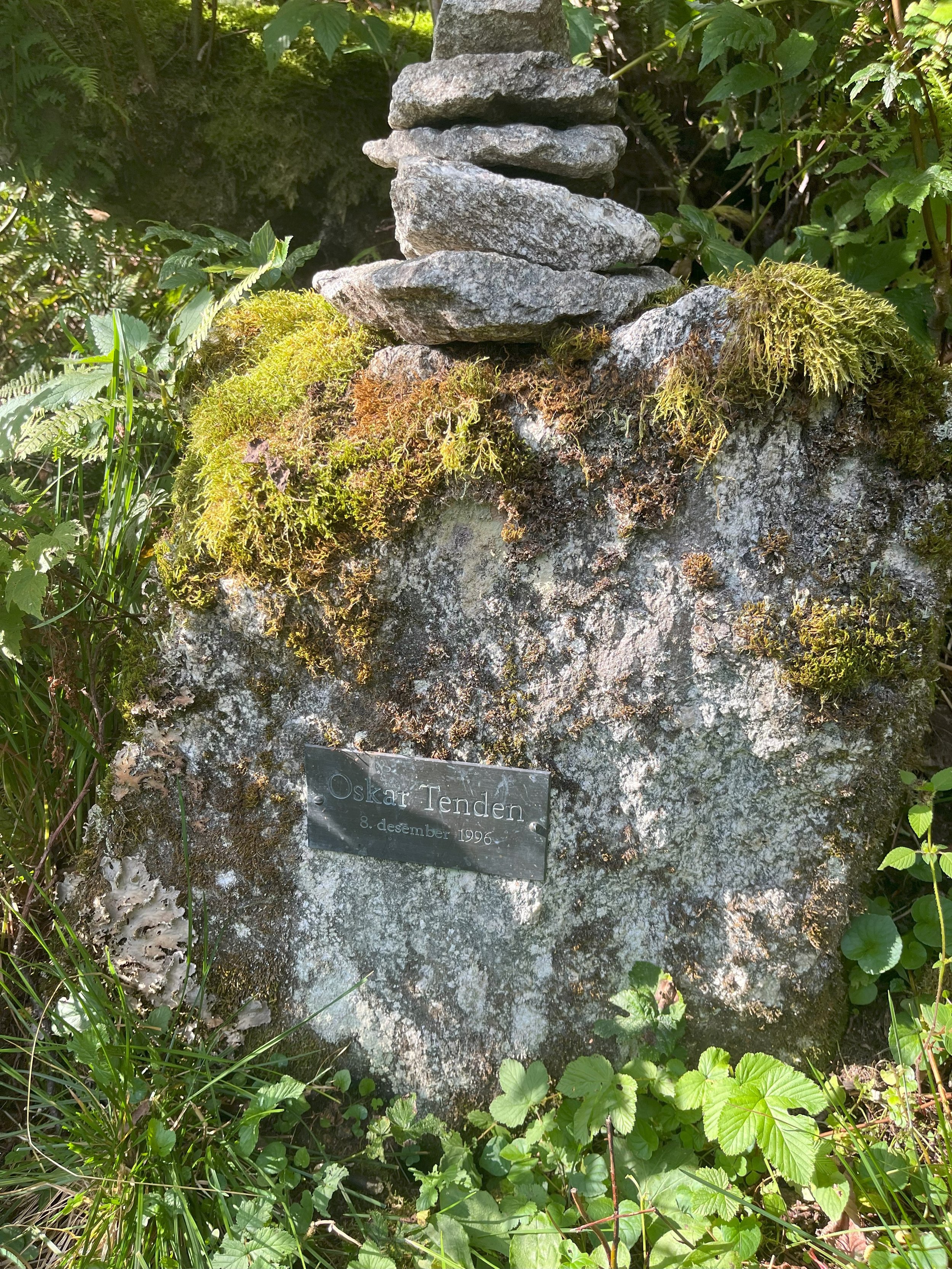The hike to Nos offers both great nature experiences and a lot of cultural history. It is a magnificent landscape, and you get to experience three disused summer farms and the Segestad mountain farm.
Difficulty: Demanding. This hike requires good physical fitness and experience with walking on uneven terrain.
Length: 5,5km one way.
Elevation gain: 500m
Duration: 5,5 hours round trip
Season: Spring - Autumn
Parking: You can park at the parking lot located about 200 meters from Glomnestunet. Please remember to pay the fee!
Note: The hike is in an area with no cellular coverage, please download the PDF with hike description before leaving.
In spring and early summer, it is common to encounter snowfields at Pikeskargrova and Tverrelva.
Hike to Nos/Bolstadsetra
Hike description
From the car park it is about 5.5 km to walk to Nos/Bolstadsetra, and there is a height difference of approx. 500 meters. You should allow five and a half hours for the entire hike.
You must be in reasonably good shape and have some experience of going off-road to embark on this hike.
The hike offers both great nature experiences and a lot of cultural history. It is a magnificent landscape, and you get to experience three disused summer farms and the Segestad mountain farm.
You can park at the car park 200 meters from the Glomnes farm. Please remember to pay the fee!
You go through the Glomnes farm, cross the river Glomsdøla and turn off to the right up a steep hill. The path further towards Segestad is easy to find.
Just before the path winds up through the steepest section towards Segestad, you can see a sign pointing towards Hellskora. It is only a short detour to this great viewpoint!
When you get to Segestad, you should take a look into the barn. Here, Svein Sunde has created a small farm museum with old tools and boards that tell the history of the mountain farm. The house stands as it was when the last occupant passed away in 1961. It is open to those who want to take a look.
The Friends of Segestad and Svein Sunde have done a great job of keeping the buildings on the farm in good condition!
Behind the houses at Segestad, the path passes the ruins of a homestead that was covered in a snow avalanche in 1902. The house was not rebuilt after this.
A short distance further along the path you come to Kupegrova. During the snow-melting period and after heavy rain, it can be difficult to get across with dry shoes. In some years, avalanches can occur here.
The path towards Segestadsetra (Segestad summer farm) is of varying quality. In some places you have to walk carefully.
A little way past Kupegrova you can see a memorial stone on the right side of the path. This is where Oskar Tenden died so tragically one December day in 1996. He slipped on the ice in a stream and ended up in the Glomsdøla river.
At Segestadsetra the landscape opens up and you get a powerful view of the majestic mountains by Oppstrynsvatnet. It is nice to take a lunch break here before continuing towards Nos. There is a bench to sit on and clean water in the river.
If you look around, you will see an old dilapidated stone cabin between some huge stones. This is Gardselet, which belonged to the farm (br. no. 3) at Hjelle. They were granted cabin and grazing rights here at the end of the 19th century after a “barter trade”.
You can see the remains of Segestadselet (cabin) next to a large rock. This cabin was not maintained, and after 1925 both farmers used Gardsselet.
The walls that you can see by a large rock closer to the river are the remains of a barn that the two farms probably used together. It is impressive to see how well protected all the buildings have been against rockfalls and avalanches.
On the way to Nos, you pass Pikeskargrova and Øykjeskargrova, two small rivers. In winters with a lot of snow in the mountains, there are large avalanches here, and the snow can remain well into the summer. It can be dangerous to walk over such avalanches because the river melts the snow from below, and the snow bridges become weak. You can fall through. Be careful!
When you pass Pikeskargrova, you can take a detour to Nøkkvatnet, an idyllic little lake under the mountain. Here you can also find blueberries when it's late in the summer.
Øykjeskargrova has burrowed deep into moraine masses, and there are steep edges on both sides. On the side facing Nos, you can see an animal path that leads up from the river. Here is where the path goes.
At Nos/Bolstadsetra there is an open landscape with a nice view down the valley. You can see both Skåla (1848 masl.) and Storskredfjellet (1815 masl.) on the horizon.
There are three old stone cabins on the summerfarm. The roof has been destroyed by strong wind from Utfalla, two large snow avalanches from the other side of the valley a little behind Nos.
A path has been cleared and marked past Aksla, a short kilometer northeast of Nos. From Småslettene you have a view towards the end of the valley.
On the return trip, it may be a good idea to go via Glomnessetra and Kvilefloten and further along the east side of Glomsdøla.
When you come down to the grassy field, follow the path on the upper-side of the fence to the car park.
Remember that there are sheep grazing. Dogs must go on a leash. Show consideration and shut all the gates on your way!
The cabins at Nos are built of stones that they found on the site. It was not easy to find timber in those days. There was no spruce forest, and there was little pine forest.
It is impressive to see how much fine work has been done with the aids they had in those days.

The car park at Glomnes. Please remember to pay the fee.

Hellskora

Storekvile

Segestad. The ruins of the homestead in the foreground. In 1902, a snow avalanche destroyed this homestead. There were three people in the house, an elderly couple and their 18-year-old son. Fortunately, everyone escaped without life-threatening injuries. After this tragic accident, the house was abandoned.

A stone in memory of Oskar Tenden who died here on December 8, 1996. He was 40 years old at the time. He slipped on the ice in a nearby stream and ended up in the river Glomsdøla.

Ura. The path towards Segestadsetra is of varying quality. Here the path crosses a rocky terrain.

An old stone cabin at Segestadsetra. The cabin is built between large rocks to protect against avalanches and rockfalls.

Pikeskarfonna (avalanche). Some years, the avalanche can be much larger than this picture shows. You must be careful when crossing such snow bridges! We see the path in the foreground.

Nøkkvatnet. You can make out Nos/Bolstadsetra in the background.

The picture shows the path that passes the remains of a wall. This wall was a dividing line between Segestads’ and Glomnes' mountain pasture.

Tverrelvsbakken. We see Tverrelva/Eikjeskargrovatop left.

Eikjeskargrova/Tverrelva. It can be difficult to get over with dry shoes here. Early in summer there is usually snow from avalanches here. (The picture was taken on the way home.)

Here the path passes Nosaskredene.

The summerhouses at Nos with a view towards Skåla (1848 masl.)

We see Utfala in the background; two avalanches that come every year, some years very large.

The picture showes Segestadsetra and a bridge crossing Glomsdøla and a bench where you can take a lunch break. Clean water in the river.

On the way home.

Glomnessetra

Rjomesteinen. You can find this stone not far fromGlomnessetra. It was suitably to sit on and lean the backpack with rjome (sour cream) towards the stone.

Kvilesteinen on Kvilefloten. The stone is flat and nice to sit on, and the height is just right. The path up Glomneskleiva (from Glomnes to Kvilefloten) is steep, and it might be good to have a rest here.

Glomneskleiva. View towards Erdalen





